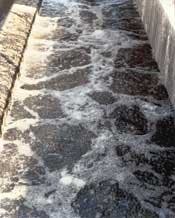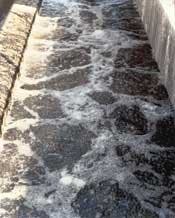by David Slack
In its July 2007 report, “Effects of Nutrient Enrichment in the Nation’s Estuaries: A Decade of Change, National Estuarine Eutrophication Assessment Update,” the National Oceanic & Atmospheric Administration (NOAA) said that nutrient pollution is getting worse in many estuaries throughout the United States, especially those on the heavily populated East Coast.
Nutrients such as phosphorus and nitrogen trigger algae blooms and reduce the amount of life-giving oxygen in the water. The report said the increased nutrient loading is linked to human activities upstream from the estuaries.
Nevertheless, the NOAA report noted that some of the nation’s estuaries have shown significant improvement in reducing nutrient pollution. One of those waterways, the Tampa Bay Estuary in Florida, has long implemented a program of aggressive nutrient management that has reversed the trend of increased nutrient pollution. Since 1978, the estuary has benefited from the use of a denitrification system that reduces nitrate-nitrogen (NO3-N) and suspended solids to meet stringent government standards at the Howard F. Curren Advanced Wastewater Treatment Plant – the world’s largest denitrification plant.
The plant uses a Tetra® Denite® denitrification system from Severn Trent Services, which was first installed in 1988 and expanded in 1992. The fixed-film biological denitrification process removes NO3-N and suspended solids (SS) in a single treatment step. The system can also be integrated with other plant treatment processes to provide total nitrogen (TN) and phosphorus removal.
The improvement in filtered effluent quality of the large flow from this plant has been a documented factor in the revitalization of Tampa Bay over the last few decades. Sea grasses and sport fish have returned to once barren areas of the waterway.
Ten years of effluent data (1997-2006) reveal the following results: average flow of 55.43 million gallons/day; biological oxygen demand (BOD) of 2.52 milligrams/liter (mg/L); TN of 2.46 mg/L; and total suspended solids (TSS) of 0.93 mg/L.
Denitrification Process
The Howard F. Curren Plant, the only wastewater treatment plant in the Tampa area, receives waste from the City of Tampa and parts of Hillsborough County.
Incoming wastewater contains approximately 200 ppm BOD, 200 ppm SS and 40-45 ppm total Kjeldahl nitrogen (TKN). Effluent standards are 5 mg/l (or ppm) CBOD, 5 ppm TSS and 3 ppm TN. The plant has received a variance on total phosphorus (TP), as Eastern Tampa Bay is the largest U.S. depository of “bone rock,” which is used for fertilizer production and is the cause of background TP in the Bay.
The plant’s first treatment step is odor control, which is accomplished with an odor control spray tower that uses caustic soda to reduce sulfur dioxide.
Screen and grit removal is then performed in two side-by-side buildings. The sugar sand prevalent in Florida’s raw wastewater is removed in concrete tanks, where sand and grit slurry is pumped to Dorr Oliver cyclone separators and grit washers, then to trucks that take the grit to a landfill. These buildings also contain Hycor all-stainless-steel, self-cleaning screens with approximately two mm gaps to remove larger particles. The wastewater then goes to rectangular primary clarifiers to achieve approximately 30 percent BOD removal and 60% SS removal. The sludge from the primary clarifiers flows to anaerobic digesters where the methane gas is recovered to power the plant’s generators.
Wastewater is pumped to the high purity oxygen (HPO) basins where oxygen from two cryogenic plants, (an 80 ton/day and a 60 ton/day) is injected into the annulus of covered basins and 24 slow-speed mixers continue the BOD removal process. The wastewater then flows to another set of rectangular intermediate clarifiers, secondary sludge from the carb final tanks (CFTs) is thickened and pumped into the anaerobic digesters with the settled primary sludge. Digested sludge is then dewatered on 2m belt presses and heat dried or land applied. The resulting filter cake is elevated to a gas fired kiln where the biosolids are turned into pellets, stored and eventually sold for fertilizers.
After exiting the intermediate clarifiers, the wastewater flows to nitrification basins where compressed air is introduced at the basin bottoms through fine bubble Sanitaire diffusers. The nitrification process is completed when the ammonia nitrogen is converted to soluble nitrate-nitrogen. After final clarification in rectangular clarifiers, methanol is added to the wastewater stream as it enters the Denite filters. NO3-N levels are often in the 20-30 ppm range as belt press filtrate also is combined with the filter feed. Filtrate is returned to the HPO reactors to CFTs, nitrification diffused air reactors (DARS) to be nitrified (press filtrate has 500-1000 mg/l Nh3-N). The Denite filters remove TSS and nitrate-nitrogen in one step.
Filtered effluent then flows to reaeration and disinfection basins where chlorine is introduced. Sulfur dioxide is added to dechlorinate the wastewater after it goes over the weir before it is piped less than one mile to Old Hillsborough Bay.
As testament to the effluent’s purity, bottle nosed dolphins frequently can be seen swimming right at the discharge point.
About the Author:
David C. Slack, General Manager at Severn Trent Services, has over 40 years of experience in sales and engineering services to the utilities, steel, municipal, chemical and wastewater treatment industries, including the development of new processes in the metallurgical, electrical, food and wastewater markets. He holds a B.S. in Electrical Engineering and an M.B.A. in Economics & Management.





